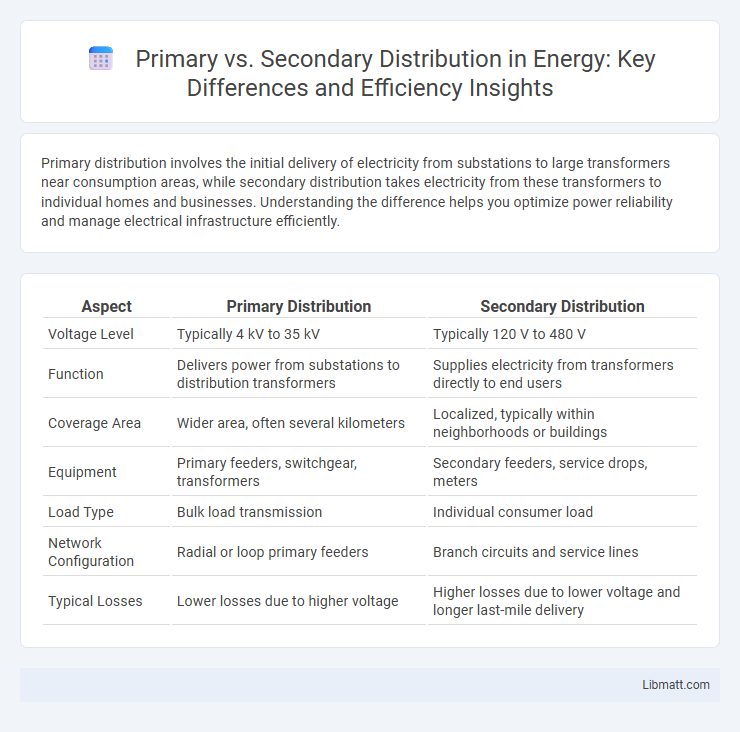Primary distribution involves the initial delivery of electricity from substations to large transformers near consumption areas, while secondary distribution takes electricity from these transformers to individual homes and businesses. Understanding the difference helps you optimize power reliability and manage electrical infrastructure efficiently.
Table of Comparison
| Aspect | Primary Distribution | Secondary Distribution |
|---|---|---|
| Voltage Level | Typically 4 kV to 35 kV | Typically 120 V to 480 V |
| Function | Delivers power from substations to distribution transformers | Supplies electricity from transformers directly to end users |
| Coverage Area | Wider area, often several kilometers | Localized, typically within neighborhoods or buildings |
| Equipment | Primary feeders, switchgear, transformers | Secondary feeders, service drops, meters |
| Load Type | Bulk load transmission | Individual consumer load |
| Network Configuration | Radial or loop primary feeders | Branch circuits and service lines |
| Typical Losses | Lower losses due to higher voltage | Higher losses due to lower voltage and longer last-mile delivery |
Introduction to Distribution Channels
Primary distribution channels involve the direct movement of products from producers to consumers, ensuring faster delivery and closer brand-consumer relationships. Secondary distribution channels include intermediaries like wholesalers and retailers, expanding market reach and providing logistical support. Understanding these channels helps optimize Your supply chain efficiency and customer accessibility.
Defining Primary Distribution
Primary distribution refers to the process of delivering electrical power from the substation to the distribution transformers through main feeders or primary feeders. It involves high-voltage lines, typically ranging from 4 kV to 33 kV, designed to efficiently transmit electricity over longer distances with minimal power loss. Your understanding of primary distribution lays the foundation for grasping how electrical energy is stepped down and safely delivered to consumers via secondary distribution systems.
What is Secondary Distribution?
Secondary distribution refers to the network segment that delivers electricity from the primary distribution substations to end consumers, typically operating at lower voltages such as 220V or 480V. It involves smaller transformers, distribution lines, and service connections that directly supply residential, commercial, and light industrial users. This stage ensures reliable power delivery tailored to consumer needs and supports the final step before electricity reaches appliances and equipment.
Key Differences Between Primary and Secondary Distribution
Primary distribution involves the high-voltage transmission of electricity from substations to distribution transformers near consumption points, typically operating at voltages ranging from 11 kV to 33 kV. Secondary distribution refers to the lower-voltage delivery from these transformers to end-users, commonly at voltages of 230 V or 400 V, suitable for residential and commercial consumption. The key differences lie in voltage levels, equipment used, and the scale of electricity flow, with primary distribution handling bulk power transfer and secondary distribution managing localized energy delivery.
Importance of Primary Distribution in Supply Chains
Primary distribution plays a crucial role in supply chains by managing the movement of goods from manufacturers to major distribution centers or regional warehouses, ensuring timely and efficient bulk transportation. It significantly reduces transportation costs and lead times, optimizing inventory levels across the supply network. Efficient primary distribution supports demand fulfillment and enhances overall supply chain responsiveness and scalability.
Role of Secondary Distribution in Market Reach
Secondary distribution channels significantly expand market reach by bridging the gap between primary distributors and end consumers, ensuring product availability in diverse geographic and retail locations. This layer enhances penetration into niche markets and local segments that primary distribution may overlook, boosting overall sales volume and customer accessibility. Your brand benefits from secondary distribution's ability to increase visibility and convenience, driving stronger market presence and consumer engagement.
Types of Products Suited for Each Distribution Level
Primary distribution channels are ideal for products with high demand and mass-market appeal, such as fast-moving consumer goods (FMCG), electronics, and automobiles, which require extensive reach and availability. Secondary distribution suits niche, specialized, or high-value products like luxury goods, pharmaceuticals, and industrial equipment, where selective placement and detailed customer engagement are crucial. Efficient allocation between these distribution levels enhances market penetration and aligns supply chain efforts with product characteristics.
Challenges in Primary and Secondary Distribution
Primary distribution faces challenges such as maintaining voltage levels over long distances, managing load fluctuations, and ensuring system reliability amid faults or equipment failures. Secondary distribution encounters difficulties including balancing phase loads, minimizing power losses, and accommodating diverse customer demands with varied consumption patterns. Effective coordination between primary and secondary networks is essential to optimize Your overall electricity delivery and system performance.
Impact on Cost and Efficiency
Primary distribution handles bulk power transfer from substations to localized areas, significantly influencing overall system costs through infrastructure investment and energy losses. Secondary distribution manages the final delivery to end-users, affecting efficiency by optimizing voltage levels and reducing outages. Your energy expenses and reliability depend heavily on the design and management of both distribution stages, balancing cost with operational performance.
Choosing the Right Distribution Strategy
Selecting the right distribution strategy hinges on understanding the differences between primary and secondary distribution channels. Primary distribution involves direct delivery from manufacturers to retailers or end customers, ensuring faster, more controlled product flow, while secondary distribution relies on intermediaries or wholesalers to reach broader markets. Your choice should align with your business goals, product type, and target audience to optimize efficiency and market coverage.
Primary vs Secondary Distribution Infographic

 libmatt.com
libmatt.com